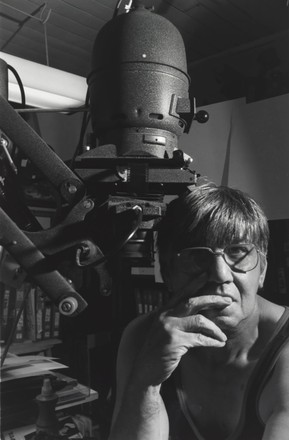Self Portrait – Sydney – 1992
Silver gelatin photographic print
PXD 653 / 22
The very modest Lewis Morley (b. 1925) was one of the most significant photographers working in London in the swinging sixties — capturing icons of the entertainment, artistic and fashion worlds such as Jean Shrimpton, Salvador Dali, Twiggy, Michael Caine, Barry Humphries, Charlotte Rampling, Joe Orton, Susannah York, Peter Cook and Dudley Moore. Today he is best remembered for his portrait of a nude Christine Keeler straddling a copy of an Arne Jacobsen ‘Ant’ chair. Lewis Morley died without fanfare on Tuesday 3 September 2013.
I’m hopeless technically
By Lewis Morley quoted in Lewis Morley: Unknown Images, Photo Review Australia, Issue 31
People
talk about you being a great photographer and I sort of feel guilty. I really
do. Because things happen to me. It has been like this all my life. I’m not
trying to be modest, I’m an awful photographer. Seriously, I’m hopeless
technically. But I improvise and that’s why I became used a lot by young art
directors in the 60s.
Studies of Australian celebrities
By Milesago – People, Lewis Morley
During
the 70s and into the 80s Morley worked extensively for POL (edited by Oz founder
Richard Walsh), Woman’s Day and the
Australian design magazine Belle,
winning acclaim fame for his immaculate colour photographs of home interiors.
He continued his work in portraiture with studies of Australian celebrities
such as John Newcombe, Juni Morosi, Marcia Hines, Brett Whiteley, Helen Glad [ the granddaughter of Norman Lindsay] and the young Nicole Kidman.
I found photography so easy
By Lewis Morley, Courting Fame (Episode 12), ABC, 2003
I found photography so easy. I mean, when I say
easy, here I was having a full life by just having to point a camera and
flicking a shutter. Now, that, I think is great. I mean, whether my photographs
are good or bad or indifferent, I don’t know, but I’ve managed to make a living
from it and I’m quite happy on that score. I've had a very enjoyable,
adventurous, exciting life and I have no regrets about being a photographer.
A relatively privileged upbringing
By Milesago – People, Lewis Morley
Lewis Morley was born
in Hong Kong in 1925 to a Chinese mother and English father. He had a
relatively privileged upbringing, raised as part of Hong Kong’s European
colonial elite, but his teenage years were dramatically interrupted by the
Japanese invasion in 1941 and the Morleys spent the rest of the war in a
Japanese internment camp.
People say life in the
camps was terrible. But I was lucky. I worked in the kitchen at Stanley
Internament Camp and got extra food. I also had a girlfriend in the camp. And
you could trade anything for a couple of cigarettes.
Morley took up
photography in his teens as a hobby, using a bakelite Brownie camera, but
during his captivity his real interest was in drawing and painting in
watercolours.
I used to swap
cigarettes for paints and paper. My drawings weren’t very good but it was a
start. I still have some of those pictures.
When his family
was repatriated to England after the war, Morley joined the RAF. In 1949, after
leaving the air force, he studied commercial design at Twickenham Art School
between 1949 and 1952.
RAF
By Lewis Morley: Unknown Images, Photo Review Australia, Issue 31
Morley started photographing seriously when he was in the R.A.F and he found the camera
invaluable on his frequent visits to Paris during the 1950s. He loved drawing architecture but it took him too long to sketch buildings. He found it
simpler to photograph them first and then to use the resulting pictures as an
inspiration and aid to memory for subsequent artistic efforts. However, it
wasn’t long before he discovered that photography also opened up other avenues
for expression.
Un-posed and with available light
By Art Gallery of NSW, Lewis Morley
Becoming
seriously interested in photography in the 1950s, Lewis Morley finally
dedicated himself to the medium following the first publication of his images,
a six-page profile in Photography
magazine in 1957. Morley began his full-time freelance photography career in
his early thirties in London, regularly undertaking reportage and portraiture
work for magazines such as Tatler, Go! and She. He was also heavily involved in theatre work, in London’s West
End. Photographing the actors in situ, un-posed and with available light,
Morley created images possessed with a fresh dynamism befitting gritty English
realist-drama.
I’m not very good at drawing people
By Lewis Morley quoted in Lewis Morley: Unknown Images, Photo Review Australia, Issue 31
I’m not
very good at drawing people but I found that I had a strength to photograph
them … I get on with people quite well … I’m not a threat. I think certain
photographers become threatening. They say ‘I’m a photographer, and you do what
I tell you to do.’ I always maintain that if you behave like a maestro, then
all your subjects become prima donnas. Treat people the way you like to be
treated yourself.
‘Shared insights of a bygone era’
By Barry Humphries, ‘Shared insights of a bygone era’, The Australian, 6 September 2013
… There are a lot of photographers in the
world and these days, with versatile cell phones, everyone is a photographer,
but Lewis was a real one.
First of all, he was an artist and a lover of art
with a great knowledge and an impressive private collection. He had an intense
curiosity so that his pictures reveal their subjects intimately and with real
compassion.
They are not just snaps but shared insights and portraits of an
epoch unmatched, in my view, by any of his contemporaries …



 Back to list
Back to list